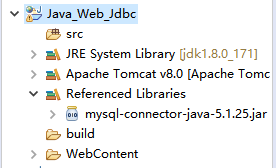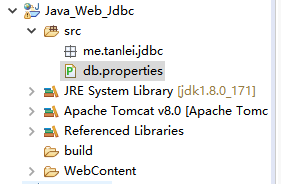一、statement对象介绍
Jdbc中的statement对象用于向数据库发送SQL语句,想完成对数据库的增删改查,只需要通过这个对象向数据库发送增删改查语句即可。
Statement对象的executeUpdate方法,用于向数据库发送增、删、改的sql语句,executeUpdate执行完后,将会返回一个整数(即增删改语句导致了数据库几行数据发生了变化)。
Statement.executeQuery方法用于向数据库发送查询语句,executeQuery方法返回代表查询结果的ResultSet对象。
1.1、CRUD操作-create
使用executeUpdate(String sql)方法完成数据添加操作,示例操作:
Statement statement=connection.createStatement(); String sql1="insert into users(CODE,NAME,STATUS) values('999','蕾蕾','生效')"; int num=statement.executeUpdate(sql1); if(num>0) { System.out.println("插入成功"); }
1.2、CRUD操作-update
使用executeUpdate(String sql)方法完成数据修改操作,示例操作:
Statement statement=connection.createStatement(); String sql2="update users set name='磊磊' where name='蕾蕾'"; int num1=statement.executeUpdate(sql2); if(num1>0) { System.out.println("修改成功"); }
1.3、CRUD操作-delete
使用executeUpdate(String sql)方法完成数据删除操作,示例操作:
String sql3 = "delete from users where id=1"; int num2 = statement.executeUpdate(sql3); if(num2>0){ System.out.println("删除成功!!!"); }
1.4、CRUD操作-read
使用executeQuery(String sql)方法完成数据查询操作,示例操作:
String sql4 = "select * from users where id=2"; ResultSet rs =statement.executeQuery(sql4); while(rs.next()){ //根据获取列的数据类型,分别调用rs的相应方法映射到java对象中 }
二、使用jdbc对数据库增删改查
2.1、搭建实验环境
1、在mysql中创建一个库,并创建user表和插入表的数据。
SQL脚本如下:
create database jdbcStudy; use jdbcStudy; create table users( id int primary key, name varchar(40), password varchar(40), email varchar(60), birthday date );
2、新建一个JavaWeb工程,并导入MySQL数据库驱动。

3、在src目录下创建一个db.properties文件,如下图所示:

在db.properties中编写MySQL数据库的连接信息,代码如下所示:

4、编写一个JdbcUtils工具类,用于连接数据库,获取数据库连接和释放数据库连接,代码如下:
package me.tanlei.jdbc; import java.io.InputStream; import java.sql.Connection; import java.sql.DriverManager; import java.sql.ResultSet; import java.sql.SQLException; import java.sql.Statement; import java.util.Properties; public class jdbcUtils { private static String driver = null; private static String url = null; private static String username = null; private static String password = null; static { try { // 读取db.properties文件中的数据库连接信息 InputStream in = jdbcUtils.class.getClassLoader().getResourceAsStream("db.properties"); Properties properties = new Properties(); // 从输入字节流读取属性列表(键,值) properties.load(in); // 获取数据库连接驱动 driver = properties.getProperty("driver"); // 获取数据库连接URL地址 url = properties.getProperty("url"); // 获取数据库连接用户名 username = properties.getProperty("username"); // 获取数据库连接密码 password = properties.getProperty("password"); // 加载数据库驱动 Class.forName(driver); } catch (Exception e) { throw new ExceptionInInitializerError(e); } } /* * 获取数据库连接对象 */ public static Connection getConnection() throws SQLException { return DriverManager.getConnection(url, username, password); } /* * 释放资源 */ public static void release(Connection connection, Statement statement, ResultSet resultSet) { if (resultSet != null) { try { // 关闭存储查询结果的ResultSet对象 resultSet.close(); } catch (Exception e) { e.printStackTrace(); } resultSet = null; } if (statement != null) { try { // 关闭负责执行SQL命令的Statement对象 statement.close(); } catch (Exception e) { e.printStackTrace(); } } if (connection != null) { try { // 关闭Connection数据库连接对象 connection.close(); } catch (Exception e) { e.printStackTrace(); } } } }
2.2、使用statement对象完成对数据库的CRUD操作
测试代码如下:
package me.tanlei.demo; import java.sql.Connection; import java.sql.ResultSet; import java.sql.SQLException; import java.sql.Statement; import org.junit.Test; import me.tanlei.jdbc.jdbcUtils; public class jdbcTest { @Test public void insert() { Connection connection = null; Statement statement = null; ResultSet resultSet = null; try { // 获取一个数据库连接 connection = jdbcUtils.getConnection(); // 通过conn对象获取负责执行SQL命令的Statement对象 statement = connection.createStatement(); // 要执行的sql命令 String sql = "insert into users(id,name,password,email,birthday) values(4,'白虎神皇','123','bhsh@sina.com','1980-09-09')"; // 执行插入操作,executeUpdate方法返回成功的条数 int num = statement.executeUpdate(sql); if (num > 0) { System.out.println("插入成功"); } } catch (SQLException e) { // TODO Auto-generated catch block e.printStackTrace(); } finally { // SQL执行完成之后释放相关资源 jdbcUtils.release(connection, statement, resultSet); } } @Test public void delete() { Connection conn = null; Statement st = null; ResultSet rs = null; try { conn = jdbcUtils.getConnection(); String sql = "delete from users where id=3"; st = conn.createStatement(); int num = st.executeUpdate(sql); if (num > 0) { System.out.println("删除成功!!"); } } catch (Exception e) { e.printStackTrace(); } finally { jdbcUtils.release(conn, st, rs); } } @Test public void update() { Connection conn = null; Statement st = null; ResultSet rs = null; try { conn = jdbcUtils.getConnection(); String sql = "update users set name='谭磊' where id=4"; st = conn.createStatement(); int num = st.executeUpdate(sql); if (num > 0) { System.out.println("更新成功!!"); } } catch (Exception e) { e.printStackTrace(); } finally { jdbcUtils.release(conn, st, rs); } } @Test public void find() { Connection conn = null; Statement st = null; ResultSet rs = null; try { conn = jdbcUtils.getConnection(); String sql = "select * from users where id=4"; st = conn.createStatement(); rs = st.executeQuery(sql); if (rs.next()) { System.out.println(rs.getString("name")); } } catch (Exception e) { e.printStackTrace(); } finally { jdbcUtils.release(conn, st, rs); } } }
三、PreparedStatement对象介绍
PreperedStatement是Statement的子类,它的实例对象可以通过调用Connection.preparedStatement()方法获得,相对于Statement对象而言:PreperedStatement可以避免SQL注入的问题。
Statement会使数据库频繁编译SQL,可能造成数据库缓冲区溢出。PreparedStatement可对SQL进行预编译,从而提高数据库的执行效率。并且PreperedStatement对于sql中的参数,允许使用占位符的形式进行替换,简化sql语句的编写。
3.1、使用PreparedStatement对象完成对数据库的CRUD操作
测试代码如下:
package me.tanlei.demo; import java.sql.Connection; import java.sql.PreparedStatement; import java.sql.ResultSet; import java.sql.SQLException; import java.util.Date; import org.junit.Test; import me.tanlei.jdbc.jdbcUtils; public class JDBCtestDemo { @Test public void insert() { Connection connection=null; PreparedStatement pStatement=null; ResultSet resultSet=null; try { //获取一个数据库连接 connection=jdbcUtils.getConnection(); //要执行的SQL命令,SQL中的参数使用?作为占位符 String sql="insert into users(id,name,password,email,birthday) values(?,?,?,?,?)"; //通过conn对象获取负责执行SQL命令的prepareStatement对象 pStatement=connection.prepareStatement(sql); pStatement.setInt(1, 1);//id是int类型的 pStatement.setString(2, "tanlei");//name是varchar(字符串类型) pStatement.setString(3, "123");//password是varchar(字符串类型) pStatement.setString(4, "bhsh@sina.com");//email是varchar(字符串类型) pStatement.setDate(5, new java.sql.Date(new Date().getTime()));//birthday是date类型 //执行插入操作,executeUpdate方法返回成功的条数 int num=pStatement.executeUpdate(); if(num>0) { System.out.println("更新成功"); } } catch (SQLException e) { // TODO Auto-generated catch block e.printStackTrace(); }finally { jdbcUtils.release(connection, pStatement, resultSet); } } @Test public void update() { Connection connection=null; PreparedStatement pStatement=null; ResultSet resultSet=null; try { connection=jdbcUtils.getConnection(); String sql="update users set name=?,email=? where id=?"; pStatement=connection.prepareStatement(sql); pStatement.setString(1, "谭磊"); pStatement.setString(2, "27300@qq.com"); pStatement.setInt(3, 1); int num=pStatement.executeUpdate(); if(num>0) { System.out.println("更新成功"); } } catch (SQLException e) { // TODO Auto-generated catch block e.printStackTrace(); }finally { jdbcUtils.release(connection, pStatement, resultSet); } } }